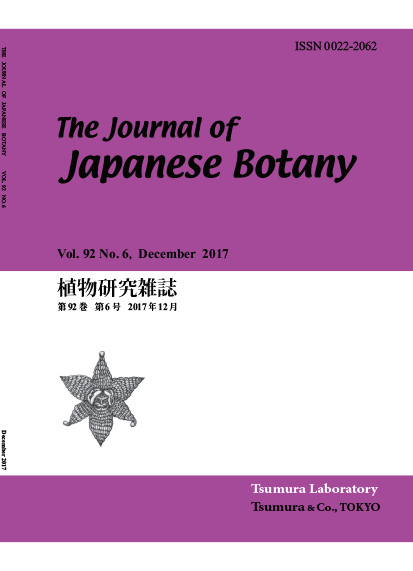
- Issue 6 Pages 321-
- Issue 5 Pages 253-
- Issue 4 Pages 177-
- Issue 3 Pages 133-
- Issue 2 Pages 69-
- Issue 1 Pages 1-
- |<
- <
- 1
- >
- >|
-
Article type: cover
2017Volume 92Issue 6 Article ID: 92_6_10824
Published: December 20, 2017
Released on J-STAGE: October 21, 2022
JOURNAL FREE ACCESSDownload PDF (249K) -
Tetsuo Ohi-Toma, Katsuhisa Ichinose, Kana Watanabe-Toma, Hiroshi I ...Article type: Originals
2017Volume 92Issue 6 Pages 321-329
Published: December 20, 2017
Released on J-STAGE: October 21, 2022
JOURNAL FREE ACCESSWe report a high degree of intraspecific variation of ploidy levels and chloroplast haplotype within Helwingia japonica (Thunb.) F. Dietr. (Helwingiaceae) in Japan. In the flow cytometric analysis, diploid, tetraploid, and hexaploid plants were detected. In chloroplast psbA-trnH analysis, 22 haplotypes were distinguished. Based on the combination of ploidy level and haplotype, 32 types of intraspecific variation were distinguished. Helwingia japonica subsp. japonica var. japonica includes a ploidy series of diploid, tetraploid, and hexaploid. It is noteworthy that plants of var. japonica in Hokkaido and Tohoku region are uniformly diploid, while some of var. japonica in west Japan are tetraploid. The distributional ranges of the ploidy levels of subsp. japonica in Japan seem to be roughly segregated, and only three sympatric populations that show two different ploidy levels were found. Considering the distributional range, the haplotype connection in the network, and the haplotype sharing among ploidy levels, one major haplotype has contributed to polyploidization in west Japan. Most polyploids might have been derived from the diversification from polyploids with the major haplotype rather than multiple polyploidzations from different diploids.
View full abstractDownload PDF (709K) -
Shinobu Akiyama, Gerard Thijsse, Hans-Joachim Esser, Hideaki OhbaArticle type: Originals
2017Volume 92Issue 6 Pages 330-348
Published: December 20, 2017
Released on J-STAGE: October 21, 2022
JOURNAL FREE ACCESSThis is part 12 of the list of type specimens and original materials of taxa described by Siebold and Zuccarini from Japan. It concerns the taxa belonging to the families ranging from Caprifoliaceae to Asteraceae according to the 12th Engler system by Melchior (1964). Seventeen lectotypes are designated and three are emended.
View full abstractDownload PDF (4806K) -
Yasushi Ibaragi, Soo-Hyun Lim, Min-Jung Yook, Kyeong-In Heo, Wenl ...Article type: Originals
2017Volume 92Issue 6 Pages 349-368
Published: December 20, 2017
Released on J-STAGE: October 21, 2022
JOURNAL FREE ACCESSThe genus Miscanthus in South Korea is revised based on herbarium studies and field observations. Three species, two varieties, five forms and one hybrid are recognized and a new combination is proposed: i.e., Miscanthus sinensis Andersson var. sinensis (further divided into four forms: f. sinensis, f. variegatus (Beal) Nakai, f. purpurascens (Andersson) Nakai and f. gracillimus (Hitchc.) Ohwi; M. sinensis var. condensatus (Hack.) Makino; M. sacchariflorus (Maxim.) Benth. & Hook. f. ex Franch. var. sacchariflorus (further divided into two forms: f. sacchariflorus and f. latifolius Adati); M. sacchariflorus var. gracilis Y. N. Lee, M. ×longiberbis (Hack.) Nakai f. longiberbis; M. ×longiberbis (Hack.) Nakai f. ogiformis (Honda) Ibaragi, comb. et stat. nov. and M. latissimus Y. N. Lee. A key to the taxa and morphological descriptions for each taxon are presented. Lectotypes of Miscanthus ionandros Nakai, M. sinensis f. transiticus Nakai, M. chejuensis Y. N. Lee and M. kokusanensis Nakai & Honda as well as Neotypes of M. sacchariflorus f. latifolius Adati and M. latissimus Y. N. Lee are designated here.
View full abstractDownload PDF (2460K) -
Hiroyuki SatoArticle type: Notes
2017Volume 92Issue 6 Pages 369-372
Published: December 20, 2017
Released on J-STAGE: October 21, 2022
JOURNAL FREE ACCESSRecently four old specimens of the Polypodiaceae were found in the Herbarium of the Hokkaido University Museum (SAPS). The specimens were presented by Mrs. Nitobe, the wife of Inazo Nitobe, to Kingo Miyabe, at that time Professor of Sapporo Agricultural College (present Hokkaido University). The collection dates were not written on the labels of the specimens, but all were collected in the Caribbean Islands. The label was handwritten by Miyabe with a note, “Presented by Mrs. M. Nitobe”. After searching various records on Inazo Nitobe, these specimens were probably collected by Nitobe himself on February 1921.
View full abstractDownload PDF (3659K) -
Hiroo KanaiArticle type: Book review
2017Volume 92Issue 6 Pages 373
Published: December 20, 2017
Released on J-STAGE: October 21, 2022
JOURNAL FREE ACCESSDownload PDF (201K) -
Editorial Board of J. Jap. Bot.Article type: Acknowledgement
2017Volume 92Issue 6 Pages 374
Published: December 20, 2017
Released on J-STAGE: October 21, 2022
JOURNAL FREE ACCESSDownload PDF (215K) -
Article type: Errata
2017Volume 92Issue 6 Pages 375
Published: December 20, 2017
Released on J-STAGE: October 21, 2022
JOURNAL FREE ACCESSDownload PDF (216K) -
Koji YonekuraArticle type: index
2017Volume 92Issue 6 Article ID: 92_6_10832
Published: December 20, 2017
Released on J-STAGE: October 21, 2022
JOURNAL FREE ACCESSDownload PDF (472K) -
Koji YonekuraArticle type: index
2017Volume 92Issue 6 Article ID: 92_6_10833
Published: December 20, 2017
Released on J-STAGE: October 21, 2022
JOURNAL FREE ACCESSDownload PDF (536K)
- |<
- <
- 1
- >
- >|